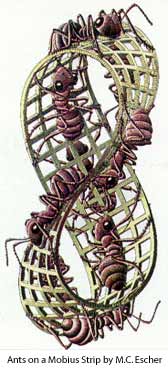Simple DC Motor DIY STEM Kit
$9.99$5
 Very roughly a surface is orientable if it has two sides so that, for example, is
it possible to paint it with two different colours. A sheet of paper or the
surface of a sphere are examples of orientable surfaces. A Mobius strip is a
non-orientable surface: you can build one with a strip of paper (twist the strip
and glue end together to form a ring) and verify that it has only one side: it is
not possible to paint it with two colours.
Very roughly a surface is orientable if it has two sides so that, for example, is
it possible to paint it with two different colours. A sheet of paper or the
surface of a sphere are examples of orientable surfaces. A Mobius strip is a
non-orientable surface: you can build one with a strip of paper (twist the strip
and glue end together to form a ring) and verify that it has only one side: it is
not possible to paint it with two colours.

 'In a way science is a key to the gates of heaven, and the same key opens the gates of hell, and we do not have any instructions as to which is which gate.
Shall we throw away the key and never have a way to enter the gates of heaven? Or shall we struggle with the problem of which is the best way to use the key?'
'In a way science is a key to the gates of heaven, and the same key opens the gates of hell, and we do not have any instructions as to which is which gate.
Shall we throw away the key and never have a way to enter the gates of heaven? Or shall we struggle with the problem of which is the best way to use the key?'